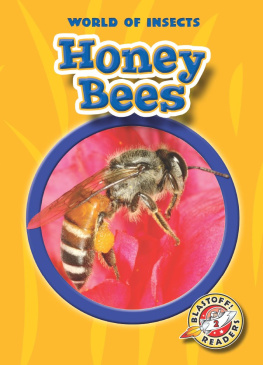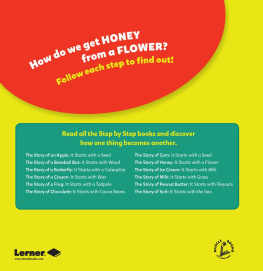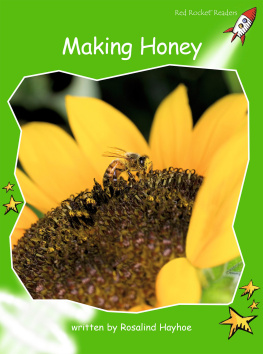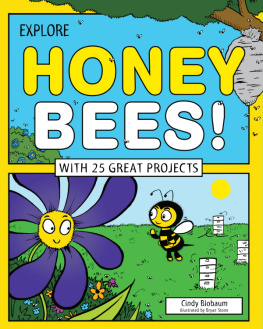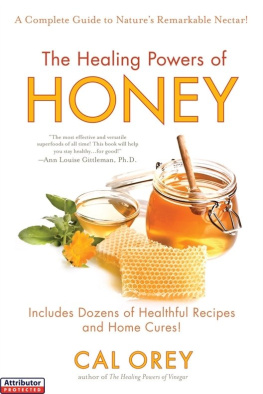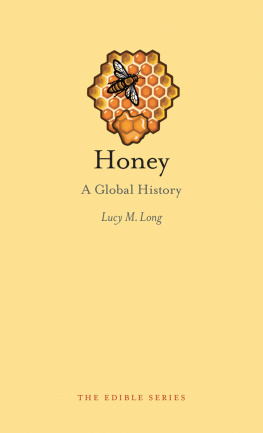A SHORT HISTORY OF THE Honey Bee

A SHORT HISTORY OF THE Honey Bee
Humans, Flowers, and Bees in the Eternal Chase for Honey
Images by
ILONA
Text by
E. R EADICKER-HENDERSON

Images copyright 2009 by Ilona McCarty.
Text copyright 2009 by E. Readicker-Henderson.
All rights reserved.
Published in 2009 by Timber Press, Inc.
The Haseltine Building
133 S.W. Second Avenue, Suite 450
Portland, Oregon 97204-3527
www.timberpress.com
2 The Quadrant
135 Salusbury Road
London NW6 6RJ
www.timberpress.co.uk
Printed in China
Second printing 2009
Library of Congress Cataloging-in-Publication Data
Ilona.
A short history of the honey bee : humans, flowers, and bees in the eternal chase for honey / images by Ilona; text by E. Readicker-Henderson.
p. cm.
Includes bibliographical references.
ISBN 978-0-88192-942-3
1. HoneybeePictorial works. 2. Honeybee. 3. Bee culturePictorial works. 4. Bee culture. 5. Honey. I. Readicker-Henderson, Ed. II. Title.
SF523.7.I45 2009
638.1dc22
2008050286
A catalog record for this book is also available from the British Library.


Acknowledgments
THANKS TO THE MANY people who generously lent their time and expertise, as well as the opportunity to photograph their hives, bees, and honey, to help make this book a reality: Bill Lewis, Bills Bees; Lisa Blackburn, The Huntington Library, Art Collections, and Botanical Gardens; Ted Dennard, The Savannah Bee Company; Ruth Ingles, Honey House; Charles Kennard; Gina Knudson; Andrea Langworthy, The Naked Bee; J. Douglas McGinnis, Tropical Blossom Honey Company; Dan and Lisa Mudd, Salmon Valley Honey; Randy, Eric, and Ian Oliver; Gus Rouse, Kona Queen Hawaii Inc.; and Richard Spiegel, Volcano Island Honey Company. Without their help and cooperation this book would not have been possible. Thanks to E. Readicker-Henderson for the poetry of his words.
ILONA
My parents, who somehow thought bringing beehives into the suburbs was sensible; Leslie, who showed where the words started; M, who opened the first flower of the story; IG, who saw the whole field; Cleo, for providing shelter from the storm; and SS, who showed there was no storm at all.
E. READICKER-HENDERSON
We would like to thank Helen Townes and Tom Fischer, who saw what this book could be, and helped make it the fine thing you have in your hands.

ONE:
The First Taste
MY FATHER HAS a dangerous combination of a straight face and a strange sense of humor, so it was no wonder that none of us believed him when he said he was going out to buy bees.
We lived in the suburbs. People in the burbs dont keep bees.
But that night, after the moonlit air had the heavy scent of orange blossoms that only comes for a few weeks, Dad drove up, and in the back of his International Harvester pickup truckits air conditioner so effective it spit icewas a single hive of bees.
A white box, maybe three feet tall, two feet to each side.
This did not, let us admit right up front, go over well. My mother fretted about complaining neighbors, my sisters objected to the very idea of bringing bugs to the house. My brother was all for it, but that only lasted until the moment he poked his face into the hive and discovered he was desperately allergic to bee stings.
Even the dog was suspicious.
So while my father and a friend moved the hive into the backyard, I took what was surely my last look at the place where my friends and I had always played catch.
How could we ever do it again? The instant we stepped out the door, surely wed be swarmed, attacked. As soon as those bees were set down, our yard would be a no-mans-land. A nokids-land.
And yet.
Raw honeycomb, the purest way to enjoy honey.
The next morning, when I woke and peered hesitantly outside through the back windows, afraid Id be able to feel the vibration of bee buzz even through the glass, it was immediately clear the bees had their own agenda. Their own work.
As soon as the sun had come up, the bees had barely paused to notice their change of address before packing off to the job. In fact, by the time I peeked over the sill, they were already well into their day, entirely busy, busy as bees, going about their fine business of transforming the world into a taste, gathering up the terrain, flower by flower.
It would be a while before I understood this, but the bees were simply doing what bees do: acting as the gardeners of the world and making their incredibly generous gift of the landscape.
Looking for a reason to be hopeful, I checked my Boy Scout Handbook. Yes, there was even a beekeeping merit badge. Maybe this wouldnt be so bad, after all.
Just how good it could be, though, wasnt revealed for a while, not until wed had the bees for a few months, not until theyd simply become another fact of home, like the stiff, dry grass underfoot. Not until after even my most skittish friends realized the bees werent going to interrupt our backyard games of catch.
One fall morning, my father went out dressed in full bee regaliathe white hood with the net over his face, the high, stiff yellow rubber gloves, his pants tucked down into his boots.
And that day, I finally learned the true magic of bees. More: I found my quest.
Dad lit a match to some newspapers, stuffed them into the bellows, which he squeezed at the hive entrance and around the openings of the top, pouring smoke onto the bees. Then he pried open the lid of the hive, took a frame of heavy comb out, holding it yellow and rich in the light. He drew his pocketknife across the wax caps, and the honey began to flow, an amber that made me think of what Id heard in science class, that it was possible to slow light down so much that it became solid.

A frame, fresh from the hive, heavy with honey.
Dad held the comb out, and my world irrevocably changed. Changed in a single, hesitant touch, tongue to honey. The pure taste of sweetness.
Nearly forty years later, Im still chasing that taste of honey straight out of the hive, honey that I saw made bee by bee, flower by flower, before we spun it out under the centrifugal force of the extractor and our whole house smelled like the inside of the worlds most delicious honey jar.
Forget the wine snobs who tell you that what they drink is the essence of the country. Honey is more than that: it is the truest distillation of the landscape, as specific to a place as the way sunlight hits flowers in the morning.
OVERLEAF: Frame of honeycomb ready to go into the extractor. The wax caps have been cut from the cells, and the honey is just beginning to drip out.

Next page

